Total Football Analysis
·8 August 2020
UEFA Champions League 2019/20: Barcelona vs Napoli – tactical preview

In partnership with
Yahoo sportsTotal Football Analysis
·8 August 2020

This Saturday night, Barcelona will host Napoli at the Camp Nou in the round of 16 second leg of the Champions League knockout stages. The first tie ended in a one-all draw between two evenly matched European titans and therefore, both have all to play in this battle in Catalonia.
For that reason, this tactical analysis will be a preview of that game and will tell just what kind of tactics we can expect from both sides tonight.
Quique Setién will be forced into a couple of changes of personnel, most notably because of the suspensions of both Sergio Busquets and Arturo Vidal. The former would have definitely been a part of the lineup had it not been for his suspension and the latter is also often a big part of the squad.
The rest of the team, luckily for the Catalans, is fit and ready to go. Marc-André ter Stegen will undoubtedly start between the sticks and will be covered by a quartet of – from right to left – Nélson Semedo, Gerard Piqué, Clément Lenglet and Jordi Alba. In midfield, Barcelona are likely to deploy Frenkie de Jong who’s covering for Busquets, Ivan Rakitić and Sergi Roberto.
Up front, the trident of Lionel Messi, Luis Suárez and Antoine Grizemann will probably make its grand return. Setién could set his team up in a 4-3-1-2 diamond, which saw its debut against Villarreal in La Liga.

On the other hand, Gennaro Gattuso will be without the services of Kostas Manolas but other than that, and Nikola Maksimović’s doubtful appearance, the Italians are all set. Interestingly, Napoli don’t exactly have a no.1 goalkeeper and predicting who will start between the sticks for them is an unforgiving task. Still, David Ospina will likely get the nod in front of Alex Meret and the Italians will welcome Kalidou Koulibaly’s return with open hands.
The in-demand centre-back has missed the first leg and is bound to make their defence even sturdier than before. Alongside him, we’re likely to see Giovanni Di Lorenzo and then Mário Rui and Elseid Hysaj on their respective flanks.
In midfield, Gattuso will most likely opt for Fabián Ruiz, Piotr Zieliński and Stanislav Lobotka for a trident that offers a lot of on-the-ball ability. Finally, the front three should comprise of Dries Mertens, Lorenzo Insigne and José Callejón.
We can expect Napoli to be fielded in their traditional 4-3-3 formation on paper.
Even though Napoli are notoriously good in possession and are one of the best teams in Serie A at keeping the ball at their feet, likely, they won’t see much of it at the Camp Nou. Much like we saw in the first leg, Barcelona will probably dominate possession and keep the Italians pinned down in their half. For that reason, one of the main focuses of this tactical analysis will be to determine how Barcelona’s build-up structure interacts with Napoli’s mid-block.
In possession, and despite Busquets being unavailable, we can expect the Catalans to drop their pivot in-between the centre-backs to form a back three. In that scenario, full-backs have the licence to push forward, provide the width and form a line of four with the remaining two midfielders. At the very least, the pivot will stay deeper to offer support for the centre-back who will be tasked with starting the first phase of Barcelona’s build-up.
Napoli are likely to retreat to their trademark 4-1-4-1 defensive block that operates in an option-oriented zonal marking system. This means they move as a unit depending on where the ball is and cover their respective zone (space) in coordination with their teammates. Below, we can see their likely approach with Barcelona’s backline in possession.
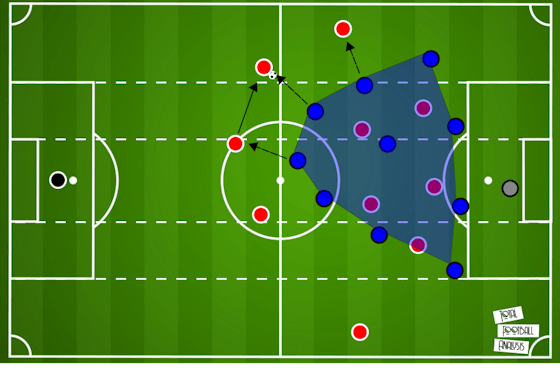
As the ball is recycled across the back three, Napoli’s press is activated. The striker jumps on the middle man, the first interior behind him pushes up on the wide centre-back and the wide man cuts off the full-back. This is one of their standard ways of pressing from a mid-block and varies depending on where the ball is once the press is initiated.
The interior midfielder can also jump on the middle man, the wide man on the wide centre-back and then the full-back engages the opposition full-back. Either way, the goal is to force the ball into the wide areas where the byline can be used as an additional man. We can see this tendency in the following two graphs that show us Napoli’s won defensive duels in their own third and recoveries across the pitch.
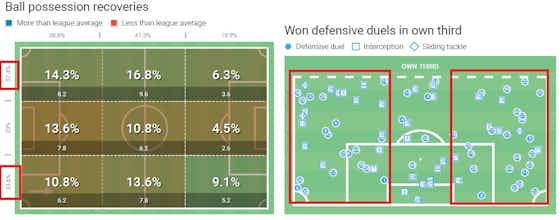
Most of their recoveries happen in the first two thirds of the pitch and the vast majority on the flanks, 37.4% and 33.6% on the left and the right respectively. Similarly, if we take a look at their won defensive duels in their own third, once again, we see their tendency to shove the opponent to the wings and then collapse on the ball. This is likely what they will also do to Barcelona at the Camp Nou.
The in-game example against Lazio can show us how this works. The structure remains the same as Napoli wait for the opposition in a 4-1-4-1 formation. Once the ball is recycled, the whole block moves but this time, as we’ve mentioned in the above analysis, it’s the wide man who presses the wide centre-back and the full-back engages the opposite full-back.
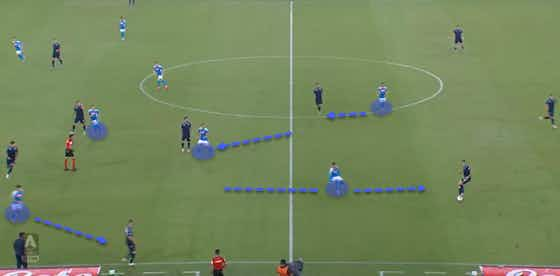
Notice the rotation in the middle as the interior covers the midfield options for the opposition and the striker covers the pivot. This means that there is no way Lazio can penetrate centrally and they will either have to go back or force their way through, risking losing the ball in a dangerous position.
When the opposition advances up the pitch, Napoli maintain their 4-1-4-1 block, only in a deeper and even narrower structure, which we can see below. This is also what we’re likely to see against Barcelona as well and is a very similar pattern the Italians used in the first leg.
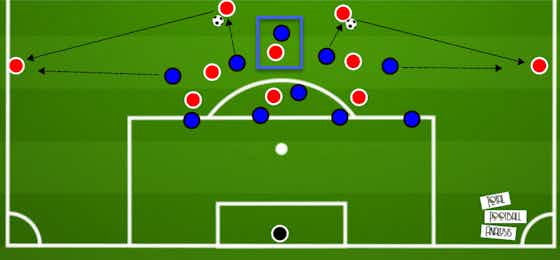
Here, Barcelona will no longer have a three in the back and will instead push all the midfielders higher along with the full-backs. You can see how narrow Napoli can be and will only press the ball-carrier in a very similar pattern to the one we highlighted earlier. The interiors press the centre-backs and the wide men press the full-backs.
This, once again, means the only way through is to exploit the wide areas – as the pivot is often kept in the striker’s cover shadow in all phases of play – something the Catalans are very bad at doing as they are one of the most central-focused teams in Europe. However, their best bet is to completely bypass the deep block and cut through the structure while it’s still disorganised. Watching Napoli post-lockdown has revealed a tendency we feel Barcelona may look to utilise.
The Italians have often faced teams who play with similar tactics with three players in the back – either a pivot in front of the centre-back duo or pivot forming a back three – during the first phase of build-up. Teams like Lazio or Inter have used it recently against them and they mostly followed the same pattern of pressing and marking. However, whenever an opponent was able to switch sides quickly, Napoli were very slow to maintain their shape and would especially lose their vertical compactness once they quickly tried to press the wide defender on the opposite side.
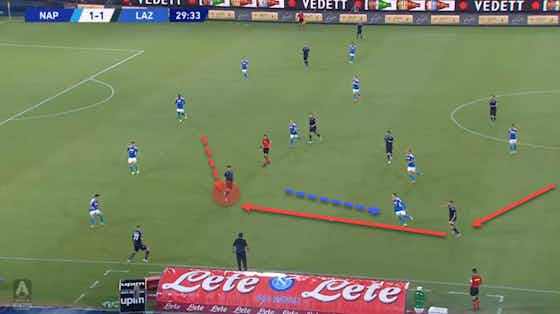
Above is an example against Lazio. They swap sides and once the second line of press is engaged in an attempt to close down the ball-carrier, a huge gap appears between the defensive and midfield lines, offering a pocket to be exploited in the half-space. We’ve seen the same thing happen numerous times in other games as well and this seems to be the way to access the inside forwards who can progress the play from those areas.
Barcelona, in particular, have the tools and the personnel to exploit those gaps if they can keep the ball moving quickly. We have seen them use similar patterns to access the half-space where either Ansu Fati or Griezmann can drift and receive the ball.
Against Deportivo Alavés, for example, they’ve been extremely successful at that, consistently using the opposition’s press triggers against them. Below, we can see something similar with three players in the back and the ball quickly going from one side to the other, making the opposition lose their markers and engaging the second line of press to free up the wide areas.
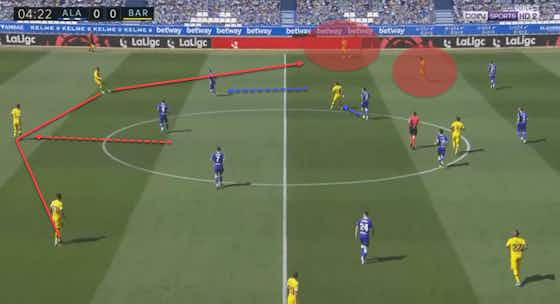
Then the ball goes out to the full-back and quickly into the half-space to find Fati. A similar pattern could and should be used against Napoli if Barcelona aim to enjoy more freedom in the final third. If they, however, go slow and face their deep block, they will rely on their full-backs to shine, which is not often the case.
A big assumption ahead of the game is that, for the majority of the first half, we’re likely to see Barcelona have the ball and Napoli play on the counter. Of course, once Barcelona lose the ball, and they will, they will try to initiate quick counter-pressing to retain possession immediately and as high up the pitch as possible.
While they are not necessarily one of the best pressing sides in Europe, they are still among the most aggressive ones, especially in La Liga. We can expect them to continue this in the early stages of the game when even Messi and Suárez engage in the press. Barcelona like to mirror the opposition’s structure and press man-on-man when advancing up the field but use collapsing tactics once the possession is yielded.
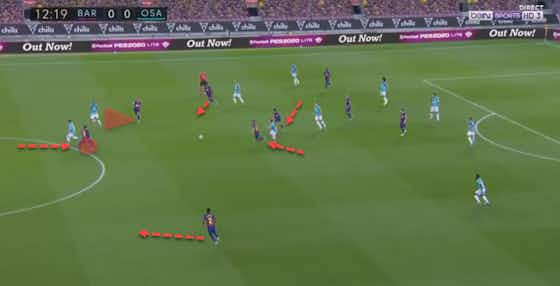
Notice the sequence in the above image. Barcelona’s rest-defence consists of two centre-backs, Lenglet and Piqué, and usually one full-back, in this case, Semedo. One of the midfielders will generally stay deeper as well and we can expect that to be the pivot, most likely De Jong in this clash.
Once the ball is lost, the players closest to it will converge, usually the player who lost it as well, while others try to cut the passing lanes, closing the channels for a quick break. One very important aspect is their tendency for one centre-back to jump out and retain possession, like Piqué in the above image. When it works, it’s great but it’s something that has cost them before and something Napoli can look to exploit as they play out of the gegenpress.
Below, once again. Barcelona lose the ball in the middle third, the players closest converge, one centre-back rushes out to press from behind while the pivot cuts the passing lane, negating a break.
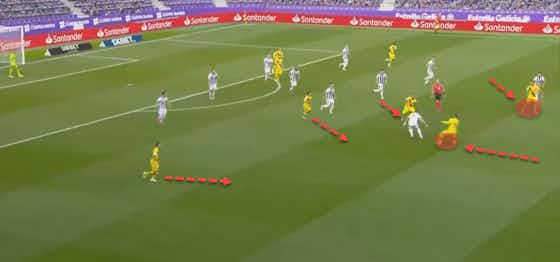
If the rest-defence is broken, the pivot will look to rush the ball-carrier while the centre-backs and the full-backs sprint back to cover the space behind their back. This is another aspect Napoli can exploit for two reasons. Firstly, Barcelona are slow in transitions, both attacking and defensive, and secondly, their main pressers, usually Busquets and Vidal, often have to cover a lot of ground to engage the ball-carrier from the deep.
Not to mention that both are suspended for the second leg, meaning the responsibility will have to be shared among the remaining players, most likely Roberto, De Jong and Rakitić. For Napoli, the key, especially in the first half, will be to play out of the counter-pressing and eject their forwards into space, something they are well capable of doing.
Players like Ruiz in midfield will be key here and the Italians’ best bet to shrug off the press and quickly transition towards the wings. Below, we can an image from the first leg when Ruiz manages to get past an onrushing De Jong to free himself and drive with the ball. After that, Napoli only need three passes to successfully transition to an isolated winger on the other side.
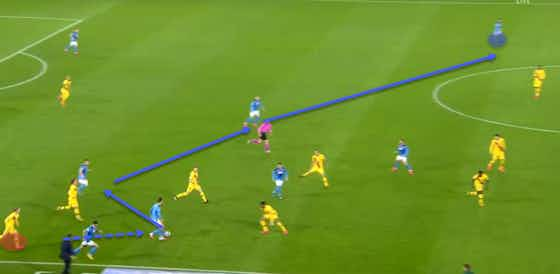
This will be the blueprint for a large part of the second leg as well. Napoli’s front three are very dynamic but also flexible, meaning they will often drop to support and overload one side of the pitch, freeing the other in the process. Leaving Barcelona’s full-backs or centre-backs isolated with Insigne or Callejón will be the ideal scenario for them.
The important thing here is the technical quality of the players who often instigate those counters. Napoli have shown time and again they can control the ball in tight areas – such as the one above – and then combine that with deep runs from midfield to carry the ball forward until it’s in the right area to be deployed out wide.
Our next example shows them beating Sassuolo’s press, similarly as they did against Barcelona. A combination out wide where they usually recover the ball and a quick one-two with a run from deep suddenly has them breaking at pace.
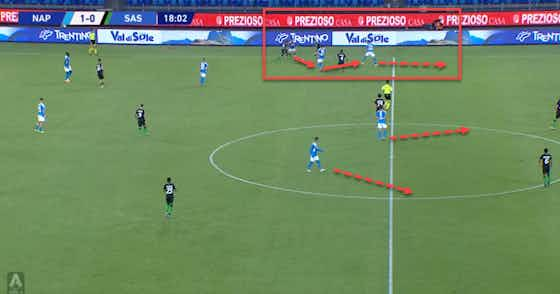
When they get to the final third and have their forwards in place, ideally isolated out wide, Napoli will often use decoy runs to create space. One winger stays wide or in his respective half-space, waiting for the overlap while two central players, usually it can be only the centre-forward but sometimes aided by a runner from deep, drag the markers away, freeing the zone 14 for an oncoming player.
In such a scenario, which can be seen below, Napoli have multiple options to threaten the opposition’s goal. They can go wide and follow up the overlap, which often ends up in a cut-back, or go straight towards the player positioning himself for a shot centrally.
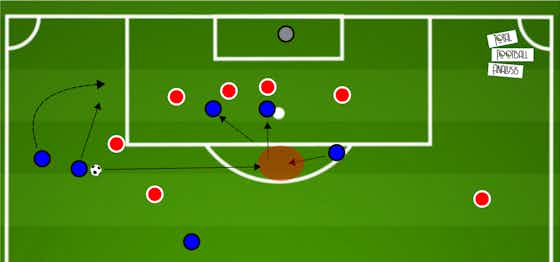
Of course, this is without taking into consideration the possibility of all three of Insigne, Mertens and Callejón, along with Ruiz from midfield, shooting from distance just outside the penalty area. They do, however, seem to favour that left flank and we can expect them to target that area against Barcelona once again.
I would expect Napoli to play safer for the majority of the first half as the idea could very much be to make it a one-goal game in the second half. That’s also when we can expect them to control more of the game and start to become more aggressive. Of course, look out for the opening moments for that as well as they will want to destabilise Barcelona from the word go.
Still, if the Catalans can get their possession game going, Napoli will defend in a 4-1-4-1 system and sit deeper. But since a 0-0 result puts Barcelona ahead, the Italians will undoubtedly push their line higher and try contesting the ball more than in the first leg.
This is, of course, dangerous as it will give the hosts the necessary space to attack, which could make or break the game for either side. At the end of the day, Napoli will get their chances but due to their necessity to attack more, so will Barcelona.
And an open game favours the Catalans immensely. That’s why we’ll go for a 2-0 victory for the home side and have them advancing to the next stage.






























































